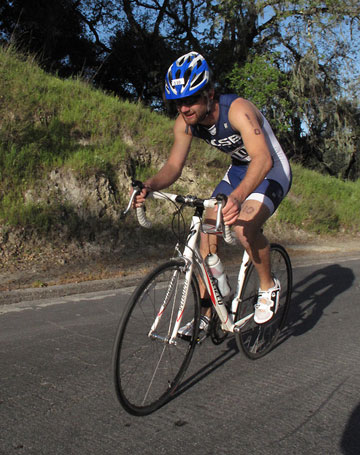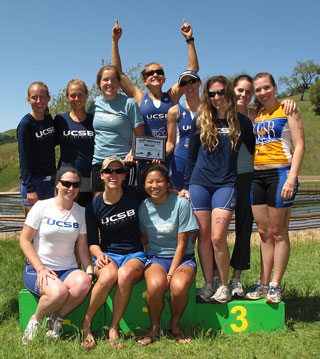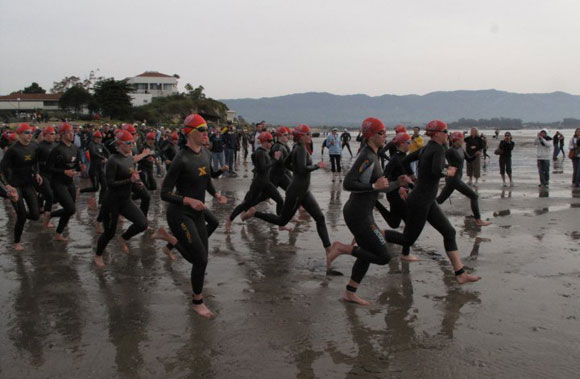
On March 20, UCSB hosts the Kendra Chiota Payne Triathlon
By David Russo
The UCSB club triathlon team has consistently been one of the top-ten programs in the country, and is on their way to repeating that success this year. Chemical Engineering major Sam Shaner and junior Chemistry major Lucy Darago, co- presidents, talked about how leadership has been a critical aspect of sustaining a highly achieving team each year.
“Since we’re a Sport Club team, most players put academics first,” Darago said. “Stepping up as a leader is all about supporting the team and being involved. It’s a balancing act.”
Shaner has worked on finding the right balance between academics and sports throughout college.
“I went to Nationals my first and second year, but last year I took a lot of time off from triathlon because I want to go to grad school,” Shaner said. “I committed myself to academics.”
Shaner is back to excelling at triathlon, placing sixth in the team’s first race of the season at the UC Irvine Zot Trot on February 13. UCSB also placed three women in the top ten: Lizzy Hendrix (fifth), Alexis Dougherty (ninth), and Alison Leary (tenth). A typical race hosted by a UC attracts 10-15 teams, which translates to about 300 racers.
“We had a lot of newcomers so it was lots of fun,” Shaner said. “Everyone had a good race.”
The biggest race of the season so far was the UC San Diego Tritonman on February 20. UCSB had over 40 racers, but due to rainy conditions, it was shortened to a duathlon, with just running and cycling.
“That was the most athletes we’ve had for a race,” Darago said. “We’re always eager to finish a full triathlon, but we’re also prepared to adapt to the conditions and perform well. We still had fun as a team and raced hard.”

UCSB's triathlon team is consistently a top-10 team nationally.
The top three Gauchos on the women’s side were Liz Whiteley (eighth), Elke Peirtsegaele (22nd), and Caroline Dezendorf (25th), with Peter Burns (eighth), Joshua Sayre (24th), and Taylor Harwood (25th) excelling on the men’s side.
The team has a few “focus races,” like at UC Irvine and UC San Diego, where it sends 30-40 athletes. Other races, like the Stanford Treeathlon two weeks ago, are not as big for the team and not as many athletes make the trip. Likewise, this last Sunday, only a few Gauchos raced at the UCLA IronBruin, but the USC Fight-On! Triathlon on March 12 will be another focus race.
“We’re excited for USC because it’s a little longer [than the usual Sprint distance],” Darago said. “It’ll be a good indicator of how we will perform later in the season and we’ll use it to help choose who goes to Nationals.”
On March 20, UCSB hosts the Kendra Chiota Payne Triathlon, which the Gauchos use to showcase more than just their athletic abilities.
“The focus won’t be on racing,” Darago said. “A majority of the team makes sure the course is safe and well managed. We’re excited to show the rest of the conference what an organized and incredible team we are.”
“We encourage our athletes to volunteer,” Shaner explained. “It’s all run by students.”
With 120 people on the team, hosting this race is just one of several responsibilities as co-president.
“There’s a lot of work that goes in to organizing it all,” Shaner said. “We arrange transportation and lodging [for each race] so all the rest of the team has to do is sign up online. I wanted to be co-president to share the knowledge and experience I’ve gained the last few years, and it’s been fun working with our officers.”

The club team has over 120 athletes involved. UCSB will be at the USC Fight-On! Triathlon this weekend.
As co-president is a big commitment, the position is only a one-year term.
“It’s a lot of work and its good for the team to switch up the leadership,” Darago said. “But I’m very glad to have the opportunity to give back to the team this year.”
On March 27, Cal Poly will host the West Coast Collegiate Triathlon Conference Championships. Last year, UCSB finished the conference in second place behind UC Berkeley.
The USA Triathlon Collegiate National Championship are April 9 in Tuscaloosa, AL. UCSB has placed sixth in Nationals for the past three years.
“Last year was frustrating because the [weather] conditions affected the team,” Darago said.
“Our goal this year is to place in the top five,” Shaner said. “It’s tough because all the military teams (Army, Navy, Air Force) are usually the top three.”
Nationals are capped at 700 racers, which means the team has to choose just seven athletes for the men and women’s races.
“We want it to be a fun experience with a cohesive team,” Shaner said. “[The top seven] will be based on performance and team participation throughout the year.”
